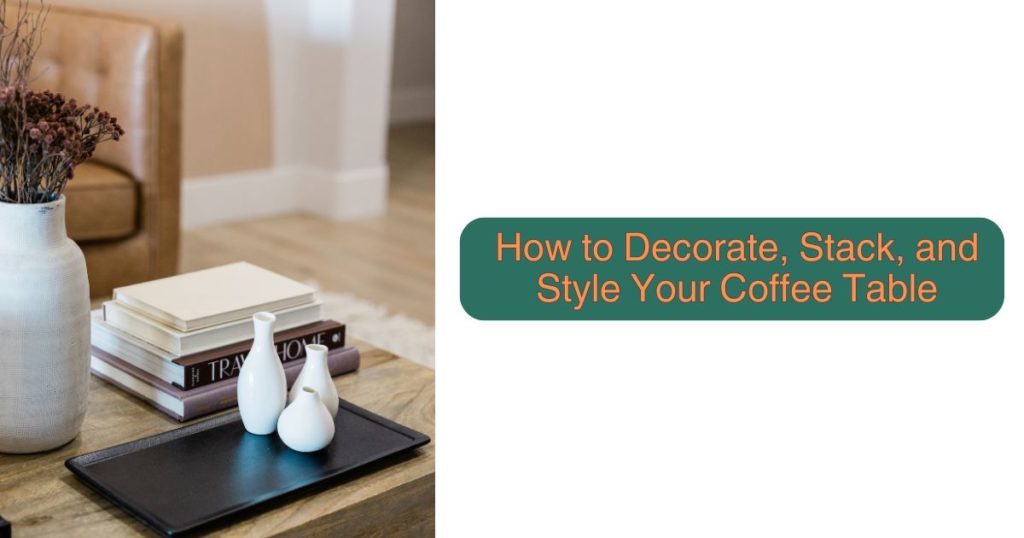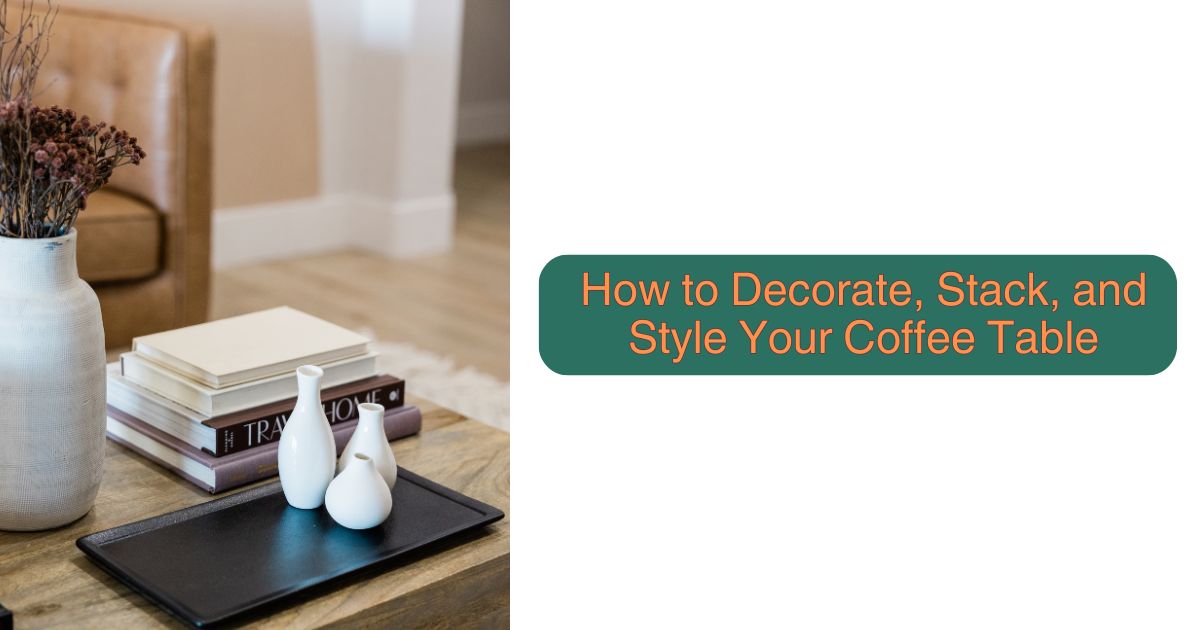How to Decorate, Stack, and Style Your Coffee Table

Organizing your coffee table can have a larger impact on your room than you may think. By using interior design techniques and concepts like biophilia you can help spark conversations, with the rule of threes you can create balance and comfort as it is visually appealing, and having the right color tones can help a room feel more spacious. Even the height of the decor items and balancing effect they provide can impact the feel of the room and its purpose.
Taller items like a vase with flowers in a striking color can break the line of sight from a room helping to create a focal point. This comes in handy for open floor plans and larger spaces. Flat and linear items like elongated glass bowls and coffee table books will keep eyes drifting past so it’s easier to focus on TVs and expand the visual feel of the space.
The guide below will help you master these concepts so you can adjust your coffee table decor helping to make sure the room conveys the right mood for the room’s purpose including entertaining guests, grounding sections of large spaces, and bringing calm through balance.
Use the Rule of Three
The rule of threes in interior design is using odd numbers (primarily in sets of three) to create visual interest where you select items or colors in groups of three and arrange them together. Our brains are trained to look for patterns, and using odd numbers stimulates the eye to look and remember. Incorporating this into how you style your coffee table can create a balanced and visually appealing effect, even when using objects of different heights.
One example can be with three coffee table books. Stacking them in a pyramid shape with the largest on the bottom and the smallest on top creates a visually appealing pyramid. They can also be coordinated based on color or three unique topics like photography, fun facts, and local history so that guests have multiple topics they can browse while you’re in another room!
The rule of three also applies to different types of objects and grouping them into sets of three, five, or seven. Start with the books stacked in the center of your table. Now create a triangle by placing a tray for remote controls at one corner closest to the couch and a tissue box at the other corner near the sofa. This creates a subtle triangle using the rule of threes and keeps the items you use regularly easily accessible.
You are not just limited to books, as any odd number of total objects will work. Place smaller items like coasters on all four corners of the table with a vase in the center. The result is the person’s eye running smoothly from one object to the next, and all paths leading back to the center for balance. This flow prevents the table from appearing cluttered even though you have used the entire space. The result is a vignette, a small area of interest within your room, that tells a story.
Pro tip: Using the rule of three to arrange your table prevents the appearance of clutter on your table, freeing up space for drinks, snacks, and hobbies. In addition clutter can cause competition for a person’s brain when it comes to being able to focus on the conversation or people in the room.
Objects with different textures can draw the eye to the table as your guests subconsciously look for a pattern in your created vignette. One way to do this is to incorporate the rule of three in a textured centerpiece by creating a base with a wooden tray or wicker basket. In the center use a smooth or textured glass vase with two tall decorative candlesticks on either side. Fill the vase with flowers for a touch of softness, and you have created texture and followed the rule of three!
How to Use Color
The colors of the objects you choose can have a big impact on the effect of the vignettes you’re putting together. If unsure where to start, choose three colors and proportion them based on the 60-30-10 rule.
60% of the objects are one color, 30% are a complementary color that is different enough to draw interest, like blue matched with purple. The last 10% can be an accent color that adds character or acts as a neutral. An example would be a bouquet with blue flowers inside a rounded purple vase placed on a white tray in the middle of a table.
Next place a blue tissue box on the tray with blue and purple marbled coasters. The blue elements will visually take up the most space and attention accounting for 60%, purple elements for 30%, and the white is a neutral 10% that pushes attention back to the pops of color.
Pro-tip: If you want to use a monochromatic color scheme for the objects on your table, apply this rule by looking at the room as a whole. 60% is the color of your walls, 30% is the color of your furniture, and 10% is the objects on the table that accent the room.
The colors themselves create different effects. Light neutral colors, like pastels, whites, soft browns or greys, and glass, can make the room appear bigger and brighter. Light will reflect off the surfaces and create the effect of spaciousness.
Darker shades can draw the eye in and create a cozy atmosphere using warm colors like maroon, deep oranges, wood, and dark greens. Based on the principle of biophilia, learn more here at NIH, these nature-esque colors draw people in and can promote conversation by making people feel comfortable. Using tones of blue can have a calming effect, making the room cozy, with darker shades adding a touch of sophistication.
Choose bright accent colors like red, yellow, orange, or neon shades to draw eyes to your table instantly. These colors create a bright point on the table. Using them as accents instead of the primary color makes the room seem livelier without risking eye fatigue. These loud colors add a cheerfulness that might be necessary during the depressing winter months when there is less natural light.
Pairing your Coffee table with an Easy Centerpiece
The most effortless centerpiece for your coffee table is a vase. As a general rule, arrange your flowers in the middle of the table, as the blooms will automatically draw guests’ eyes, and your vase will be better protected from passersby.
- For solid wood textured tables, choose a glass vase. This will gather light to highlight your bouquet as it reflects and bounces off the flowers. Seeing the stems and water in the vase makes the flowers seem as if they are growing out of the table.
- Glass tables pair well with solid-colored or patterned vases that will not blend into the table. To avoid scratching the table, add a table runner, placemat, or tray to avoid direct contact between the glass table and other glass objects or ceramics with rough bottoms!
- White or black furniture pairs well with most materials, including modern metal vases. For an artsy touch, use brightly colored vases in primary colors like yellow, red, or blue. This combination echoes modern abstract art and instantly creates a vignette from the color story.
Matching Object Heights to Your Needs
Choosing between short or tall objects for your table depends on how you intend to use the coffee table and the space around it.
When to Go Short
Choose shorter objects or stacks if you anticipate a lot of activity in the room. This decreases the chance of your careful arrangement being knocked over when guests stand up or blindly reach for their drinks while staring at the TV.
Lower decor also does not block a line of site helping eyes to drift freely and make a room feel more expansive. If you love having flowers, a short vase allows the eye to easily wander from the flowers to the books or other objects on the table.
Alternatively a bowl with a cluster of hydrangea flowers gives texture through their light blue color adding airiness and calm to the room. They can be paired with a stack of books that are not taller than the vase, smaller decorative bowls, or shallow trays. This display leaves the table’s edges free, and you can place the hydrangea bowl on top of your book stack to create more space.
Other short decor items can include a chessboard or other board game, a porcelain teapot and matching tea set to create a sophisticated corner for the adults to gather and relax, and hand blown glass dishes.
Pro-Tip: If you’re concerned about allergies or pets, fake flowers are a cost-effective option that keeps your arrangements looking fresh the entire season! Incorporating fake or living plants has been shown to improve peoples moods, creating a comfortable and relaxing atmosphere.
When to Go Tall
A combination of taller objects is a good option for the coffee table in a quiet sitting room or large and open space. In large rooms or homes with open floor plans, tall vases give the eye an immediate resting place to ground the space as a focal point.
For example, a tall vase where the bouquet reaches the height of a seated person’s shoulders paired with some decorative candlesticks. In this space, the vase and its contents become the focus. The vase also adds a neutral place to look when in conversation.
Elevated candles for a romantic gathering or where you want conversation light people’s faces and warm the space when lit. The focus on faces vs. drinks and plates on the table may help to keep conversation flowing and eyes on each other vs. drifting around the room.
If you feel down in the winter months, incorporate aromatherapy through an incense burner or flower arrangements to control the atmosphere. Lavender looks pretty, and its calming smell positively affects mood. Sage, eucalyptus, jasmine, and candela flowers are also used in aromatherapy and easily added to bouquets.
In addition, going tall increases your range of arrangement options. Peacock feathers add a touch of drama as a non-floral way to use tall vases. Tall blooming flowers like larkspur or delphinium that might lack support in smaller vases can be used with a higher vase for flair.
Your coffee table can set the mood for yourself, your family, and guests in the room. By knowing how to create a balanced space, comfort or energy, and keeping eyes focused on specific elements you can create an inviting, energetic, or calming space by simply adjusting your coffee table decor.








